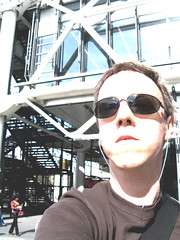Post Future of Web Apps Summit
Mike Priddy and many others have already posted lots about the Carson Systems Summit in the nearly two weeks since 820 delegates got together to chat, blog & knock heads on the Future of Web Apps, but I thought I'd add my two cents, with the benefit of some thinking time having elapsed. Mike's made a lot of the salient points about the way Carson tapped into the interconnectedness of blogs, Flickr, Technorati and collaborative tools, empowering the audience with little more than lots of 240v AC, some WiFi and the futureofwebapps tag to generate numerous on-the-spot reports (including my own notes), photostreams, and groupthink media.
Carson's audience is tech-savvy, plugged-in and laptop-toting in a way most conferences can't hope to match, but there are still things that we can learn about getting audiences involved in the documentation and extension of content-driven events.
Can we do this for HE lectures? Having watched lecturers (myself included) struggle with generating meaningful online content to support students before and after a class or module, it was amazing to witness what can happen when you let an engaged audience use their tools of choice to participate in documentation at the point of delivery.
That last point is probably critical: No-one's going to go home and type up 4000 words of speaker notes, but if you can remove the friction on the spot (free network and power, the simultaneous presence of the speaker and the slides, and the 'many hands' collaborative help of your peers) and incentivise the contribution (kudos, links, and Technorati rankings) then you might just get your audience making better, more timely, and more relevant media than you could possibly hope to do so yourself.
There's another important point wrapped up in this, and that's that the systems you choose/build/deploy need to be optimised for this sort of real-time audience participation. Trying to use our regular e-learning systems simply won't cut it; they're generally far too geared towards the delivery of official documentation (module profiles, assignments), records of events (eg presentation slides or prepared video) and after-the-fact support (discussion forums, follow-up notes). The sorts of tools we need will emphasise live annotation/tagging/editing, media sharing, and groupthink pattern identification. At a later point we'll get to some specifics, but this will serve as a starting point for further discussion of just what fits the bill for our own experiments with this.
Technorati Tags: Conferences, Creativity, Education, Flickr, Future, futureofwebapps, Futurilla, Internet, Long Tail, Media, Social Networks, Software, technology, Web


1 Comments:
One major difference between the Carson Summit and lectures, is the fragile egos - of the lecturers of course. How far will a lecturer allow criticism and comment, which may be more direct in real-time. However this would be out-balanced by the value of creating media on the spot and hopefully in volume.
So who is the audience for the test? How do you encourage the students to participate?
Post a Comment
<< Home